Miniatures from manuscripts about shields, "shields", stirrups and spurs

Frame from the movie "Knight's Castle" (1990). The shoulder pads-elletes that they attached to this knight are a bit too big, and fixed them so that they move forward with him, but in general everything is very good, especially considering the time of filming. However, M. Gorelik advised him, so why be especially surprised
A. Pushkin "Ruslan and Lyudmila"
stories about weapons. Middle Ages. Why didn’t Pushkin’s Ruslan choose a shield for himself, because there, on the battlefield, he certainly had a wide choice? But because in that era, which the poem is talking about, the shields of warriors were a completely utilitarian subject and looked about the same. Barbarian Europe inherited them from the warriors of the late Roman Empire. That is, they were mostly round and had an umbon - a metal hemisphere in the center, which was needed to protect the warrior's hand, which lay under him on the handle of the shield.
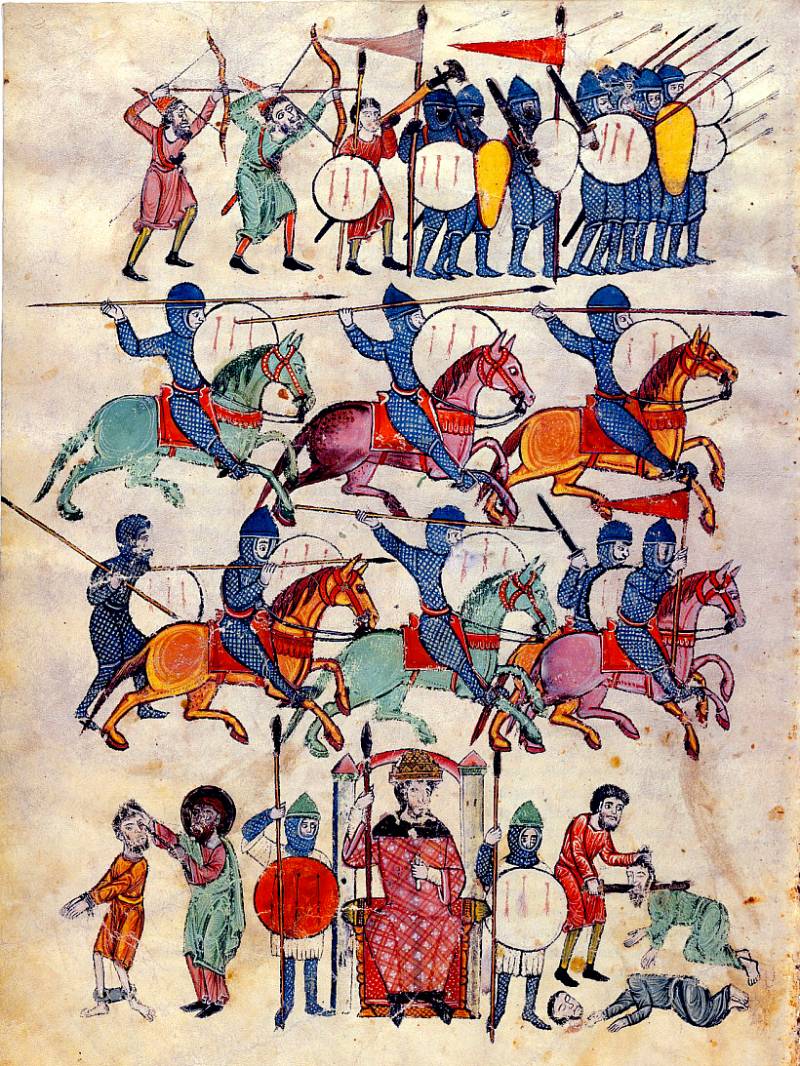
Miniature from the Beatus de Las Huelgas manuscript, circa 1220. Pierpoint Morgan Library and Museum, New York. Interestingly, their helmets already have a pommel bent forward, which is typical for the indicated time. Hemispherical helmets-servilliers are also visible, repeating the shape of the head. But round shields are most likely a tribute to the local Spanish military tradition.
They were also dressed in approximately the same way, as evidenced by their finds in different places. Lime boards were taken (it was not for nothing that the Vikings called the shield “Linden Protection”), superimposed one on top of the other and glued together with “fish glue”, after which an umbon was installed on the fasteners in the center, and behind it was a wooden crossbar handle.
In some cases, the shields were additionally covered with leather and painted with natural mineral paints. The diameter could be approximately 90 cm, and the thickness 15–30 mm. That is, the slats were laid either in one layer or in two - one across the other. Moreover, both riders and foot soldiers used such shields.
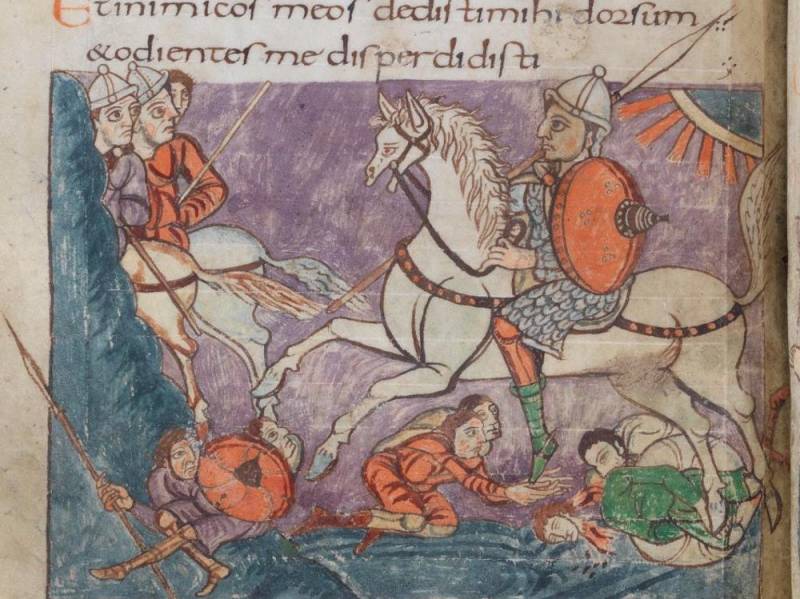
Miniature from the Stuttgart Psalter, 801-850. Place of origin: Paris, France. State Library of Württemberg, Stuttgart. In this drawing, the shield and umbon are clearly visible, and even the rivets on the surface of the shield for the belts for which it was worn. It is interesting that the illustrator depicted even such a trifle as awl-shaped, typically Roman spurs, but for some reason “forgot” to draw stirrups. Or maybe they were just appearing in Europe at that time, having made a long journey from the north of Korea * through all of Asia and to the European plains?
And now you have to digress a little, but only for the good of the cause.
Working with miniatures, I noticed that the images on some do not quite correspond to chronological realities. For example, the convex “Frankish shields” from the “Stuttgart Psalter” correspond to their time, that is, the time of its writing, but the shields from the “St. Edwin Psalter”, compiled in 1155–1160, named after the scribe Edwin, a monk from Christ Church in Canterbury (now Canterbury Cathedral), now owned by Trinity College, Cambridge, and kept in Wren's library - no!
I had to conduct a whole investigation, as a result of which it was possible to find out that this miniature was copied, like some others, from the earlier "Utrecht Psalter" of 820-835, stored in the university library of the city of Utrecht. Well, the artist just took and mechanically redrawn the old illustration.
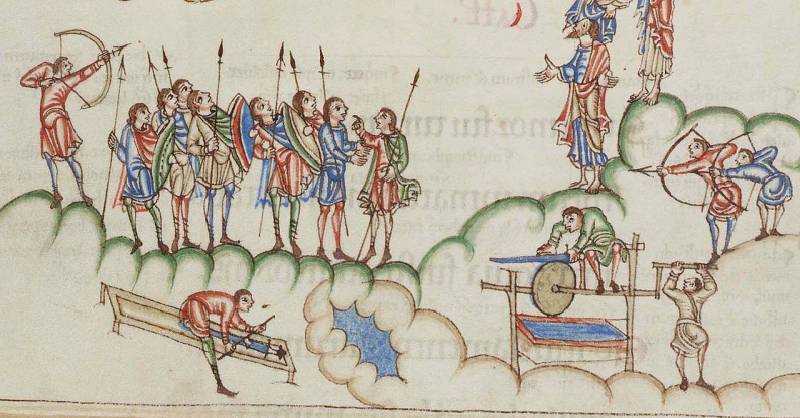
Miniature from St. Edwin's Psalter, 1155-1160.
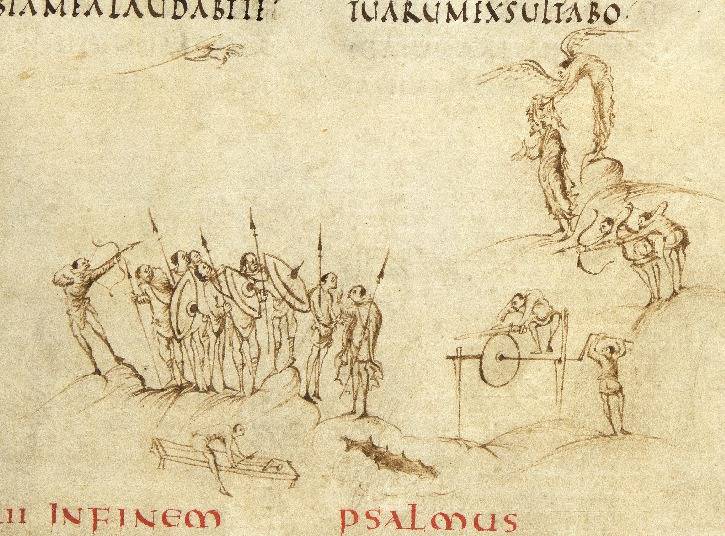
And this is the same miniature from the Utrecht Psalter of 820-835, which was used as a model for copying two centuries later! So it turns out that the artists of the Middle Ages, although they did not own historical thinking, but they were very good at copying the work of previous illustrators! So they, too, sometimes should be checked before drawing conclusions based on the illustrations they have made.

But on the miniatures of the "Psalter of St. Edwin", which were not copied, but were made later, the shields of the soldiers were already drawn in the form of an "inverted drop"! "Edwin's Psalter": torn leaf with miniatures from the preface, circa 1150. Pierpont Morgan Library and Museum, New York
Obviously, by 1066, the round shield had ceased to cope with its purpose and was pulled down so that it covered the rider at least one leg, and even if such a warrior had to fight on foot, he was no longer threatened with an insidious blow with a sword on his legs because under the lower edge of the shield!
In England, such shields in the form of an “inverted drop” are still called “serpentine” (from the word “kite” - a kite). And they were also called “Norman” and “Norman” shields, depending on what was meant - Normandy, from where William (Guillaume) the Conqueror set off to conquer Britain in 1066, or its inhabitants - “Normans” or even “Normans” ".
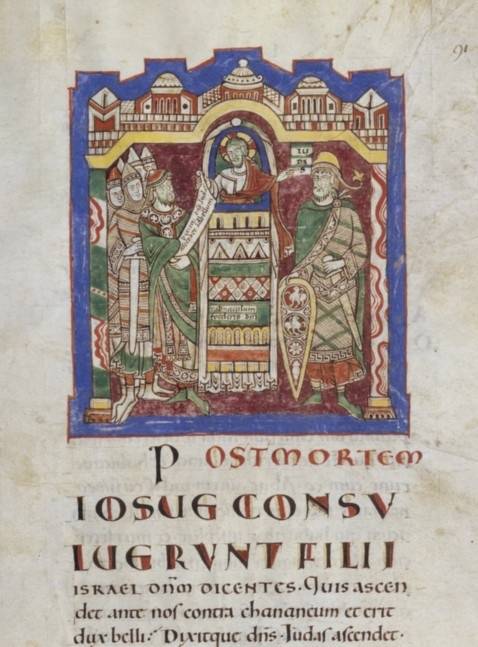
Painted shield. "Bible", 1000-1200 National Library of France, Paris
And then painted emblems appeared on their shields. So, on the "embroidery from Bayeux" you can see multi-colored winding crosses and dragons. And on the shields from the Chronicle of Chronicles manuscript you can see multi-colored stripes. The dimensions of the shield allowed them to cover themselves from head to toe, but at the same time it was both very heavy and clumsy.
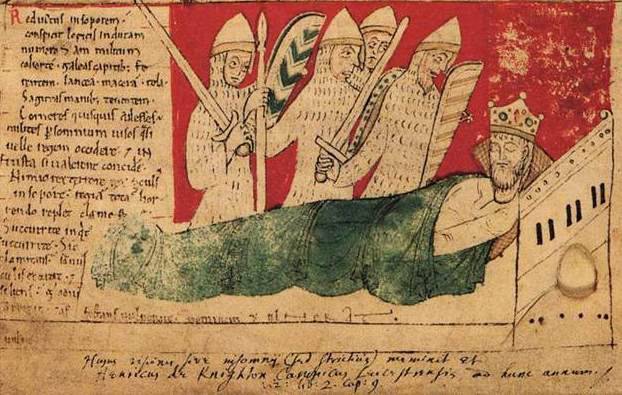
Striped shields from the Chronicle of Chronicles by John of Worcester. Miniature: The Vision of Henry I, c. 1140 Corpus Christi College Library, Oxford. Companions of Henry in chain mail and with shields came to kill him in a dream
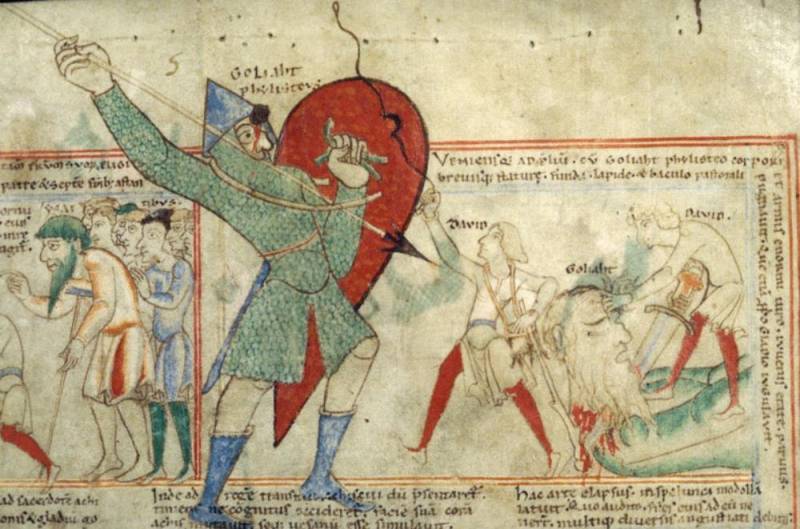
Characters already familiar to us: David and Goliath from Stephen Harding's Bible, 1109-1111. Burgundy, France. Municipal Library of Dijon. The shield depicted here must obviously be very heavy!
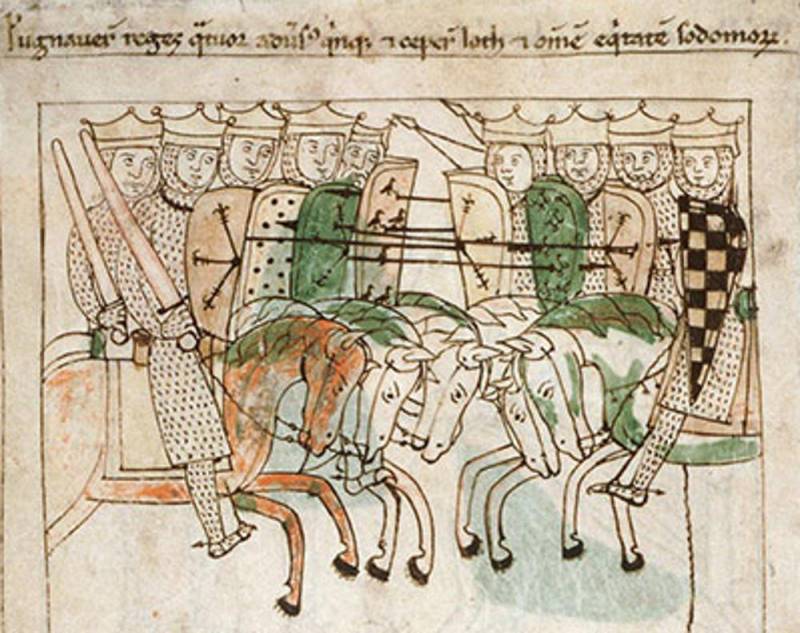
Well, the front surface of such a shield at that time could look like a miniature from the Navarre Picture Bible, 1197 Pamplona, Spain. State Library, Madrid. That is, the shields of these warriors had not yet become emblems of arms, but they had already begun to draw “chessboards”, stars with lily-shaped ends and “birds” on them
I must say that the end of the XIII - the beginning of the XIV century was marked by many innovations in the field of protective weapons, which significantly changed the appearance of warriors and knights in the first place. The appearance of metal knee pads and leggings immediately affected the size of the shield, which immediately drastically decreased in size and took the form of ... "iron". Now they have already begun to depict knightly coats of arms, it has become almost impossible for a Western European knight to simply “raise a shield without choosing”. After all, they recognized him now precisely by the shield and patch clothes, as well as by the horse blanket!

Poet and knight Waxmuth von Künzingen. Codex Manes, ca. 1305 - 1315 Heidelberg University Library, Baden-Württemberg
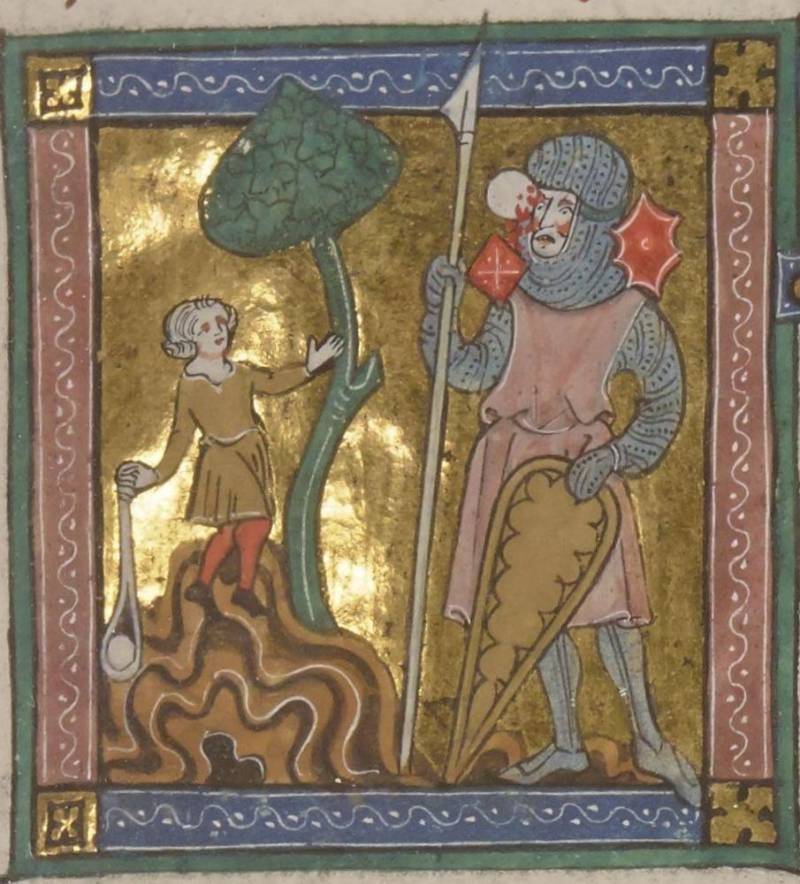
Here we have clearly Goliath-original. He is already dressed in greaves and knee pads, traditional for the French chivalry of those years, but for some reason the elletes are of different shapes. They probably wore it that way too, but what was the point in that? "Historical Bible". OK. 1300–1325 Saint-Omer, France. National Library of France, Paris
However, all this seemed to the knights not enough, and they came up with the idea of wearing “shields” (elletes, espaulers) on their shoulders, on which the image of his coat of arms was also applied.
They had the most diverse form: squares, rectangles and even disks and rhombuses. At the same time, they did not play any protective role, since they were made from “boiled leather”, or even simply from plywood covered with fabric. Moreover, despite their apparent simplicity, they were by no means a cheap decoration. For example, Pierre Gaveston, favorite of King Edward II, wore "shields" trimmed with brocade and pearls!
And then there was a really real "detective story" ...
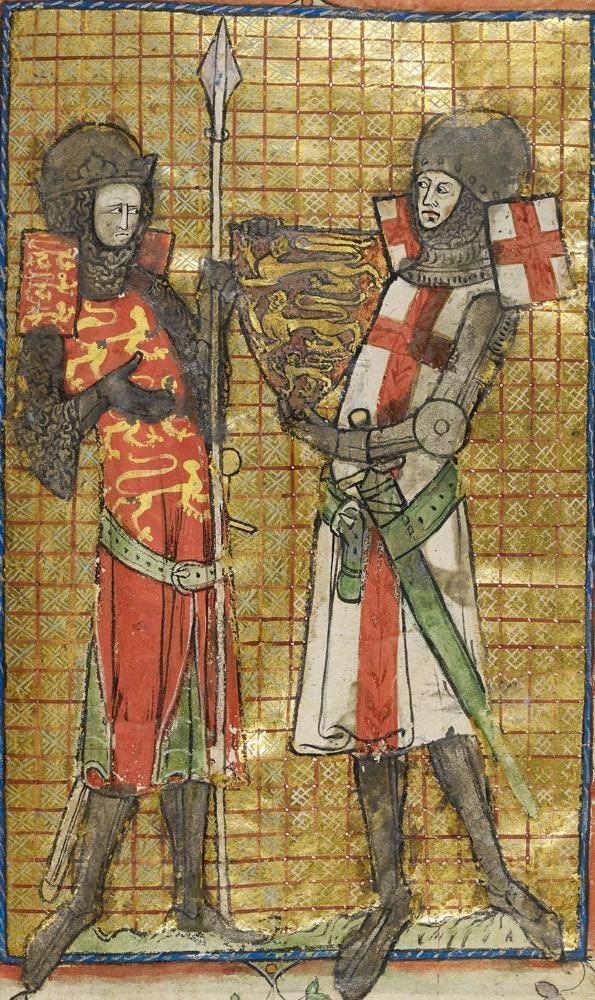
Look at this illustration from Walter de Milemet's treatise: On the Nobility, Wisdom and Prudence of Kings, 1326-1327. St. George presents King Edward III with a shield and a spear. It would seem that there is something special? And here's what: the reversal of heraldic animals on the right shoulder pad of the depicted knight or on the right side of the horse blanket was sometimes used to show their position with their faces forward, because the beast turned back to the enemy was considered “cowardly” according to the rules of heraldry. However, it was not customary to do this on a surcoat, and here we are dealing with an obvious mistake of the artist. That is, they, alas, were wrong at all times, and in the past too! Christ Church, London
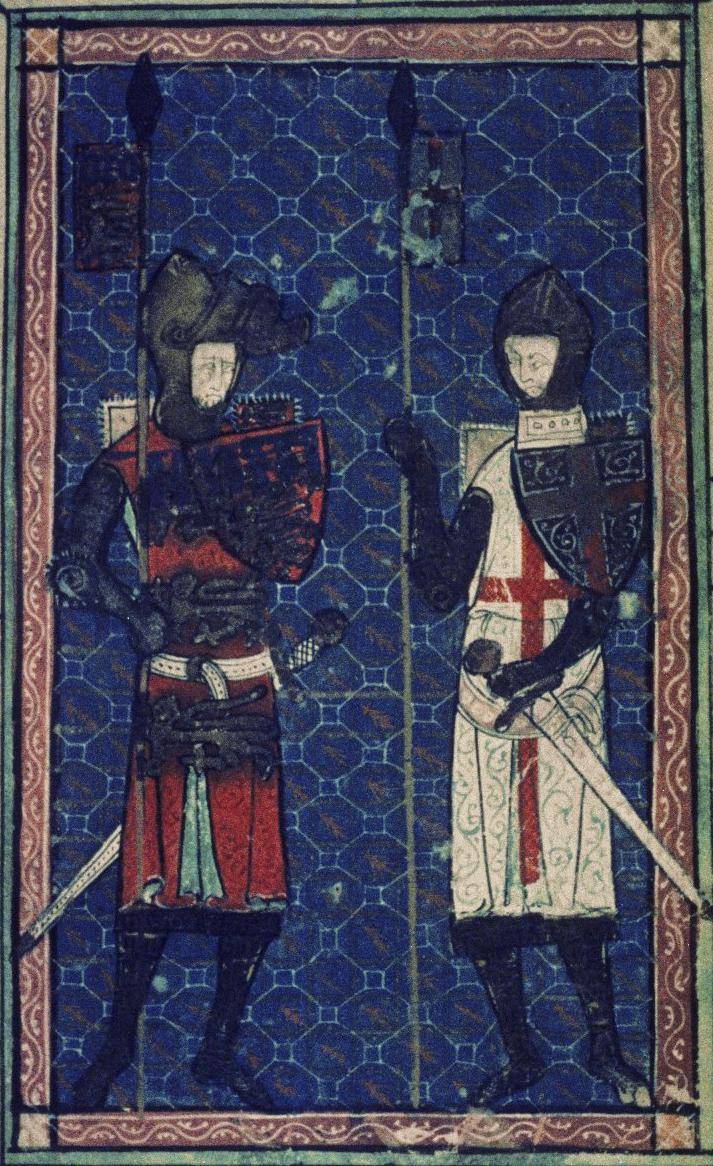
But the most interesting thing is that there is a manuscript dating back to about the same time - “Book of Hours. Use of Sarum, 1300–1320 from the Bodleian Library of Oxford University, where the same figures are drawn very similarly, but the leopards on the king's surcoat are drawn correctly!
And here's the question: who copied whom?
If the Book of Hours from the Bodleian Library is primary, and the monk from Christ Church redrawn the plot, then he was mistaken. And if the first manuscript is primary, then just in Christ Church it was corrected in accordance with the rules of heraldry. Now it remains only a little: to find out more precisely when this or that manuscript was written in order to determine who made this glaring mistake for that time.
Most likely, it is this manuscript that is primary. Indeed, on the shield we see a “lambel” (“tournament collar”), denoting the eldest son. That is, here Edward still has a living father, and if so, then ... it was from her that the drawing was made in the first manuscript and ... the correct one in it was corrected for the wrong one!
In addition, it turns out that with all the narrow limits of their work, the miniaturists of the Middle Ages were ... big dreamers and sometimes allowed themselves such things that ... "does not fit into any Bible"!
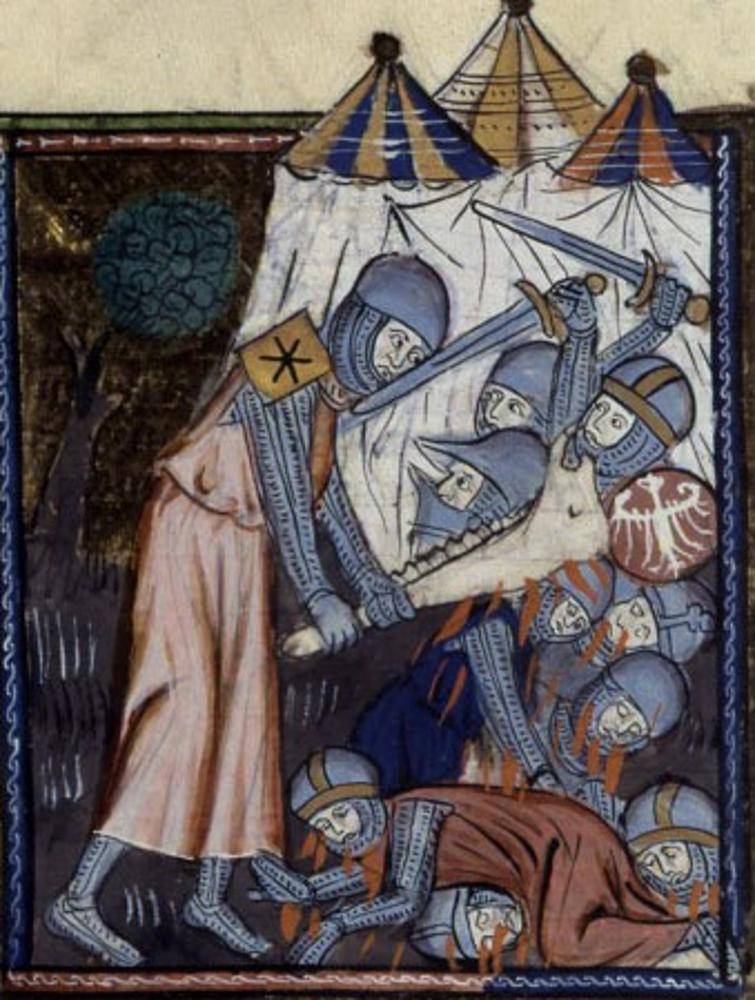
Here, for example, is a miniature from the Historical Bible, 1300-1350. National Library of France, Paris. The fact is that in the clothes of a knight with ellet shields on her shoulders, she depicts a very famous person: the Old Testament Samson, who became famous for his exploits in the fight against the Philistines and once killed a lot of enemies ... with a donkey's jaw! But how could he have heraldic "epaulettes"? Well, the jaw that he holds in his hands, rather, belongs to a crocodile, and not a donkey!
Interestingly, at the same time, the topfhelm helmet began to be attached to knightly armor with a chain. Moreover, it became fashionable to attach both a sword and a dagger to the chest by the handles with chains, so that a different fashionista knight at that time was almost completely entangled in chains! It was unlikely that it was so convenient, but fashion is omnipotent, and this innovation had to be put up with. These chains are clearly visible on the effigies. But for some reason, they were practically not depicted in miniatures.
As for the foot soldiers, already at the end of the XNUMXth century, fighting with swords, they began to use small round flat shields with umbon, called buckler. And they turned out to be so good and convenient that they were used in the middle of the XNUMXth century.
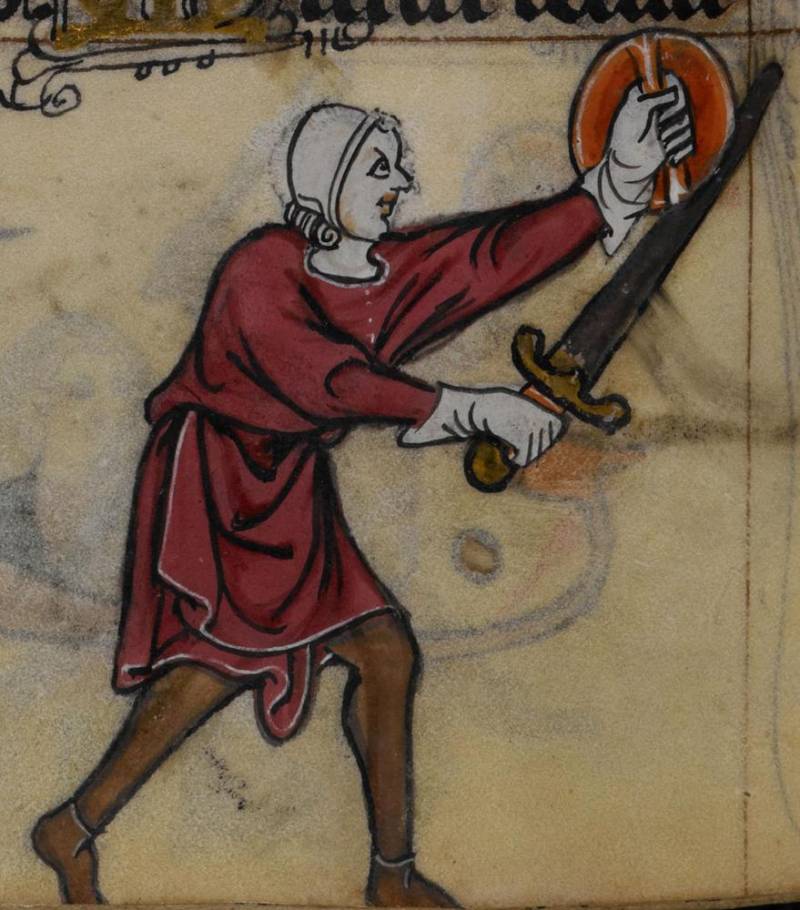
Buckler or "fist shield". "Maastricht Book of Hours", 1300-1325 Netherlands. British Library, London.
But already at the beginning of the XNUMXth century, knights received such strong solid forged armor that they almost completely abandoned shields, and if they did, it was mainly in tournaments!
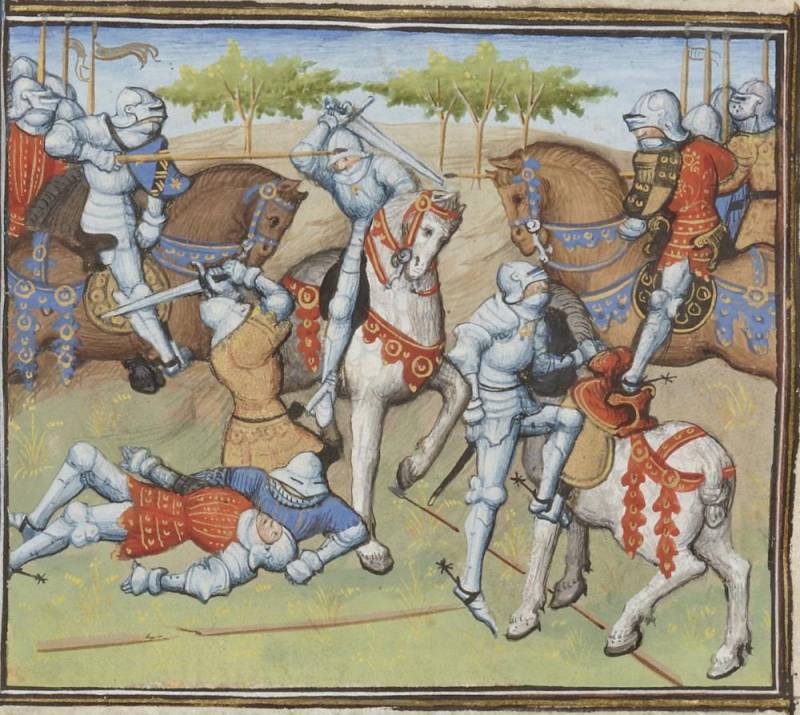
Look at this miniature of 1420. These armored men really do not really need shields! Miniature from the chivalric novel "Guiron le Courtois". National Library of France, Paris
The spurs of knight riders have changed a lot since the 1066th century. But the saddle, more like a chair with a back, has remained so since XNUMX. And all because it was precisely such saddles and strong stirrups that a heavily armed rider could rely on without the risk of falling, and turned such riders into knights. Short awl-shaped spurs, in those cases when blankets appeared on horses, led to the fact that they became very long, and even got a rotating star, with which a knight could spur his horse even through chain mail!
Information